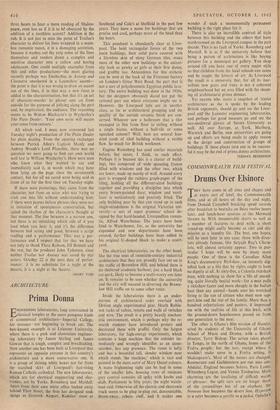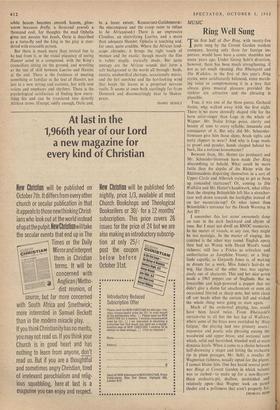COMMONWEALTH FILM FESTIVAL
Drums Over Elsinore
THEY have come in all sizes and shapes and at every sort of level, the Commonwealth films, and at all hours of- the day and night, from Donald Campbell breaking speed records after breakfast to beatniks on Ibiza twelve hours later, and lunch-hour sessions at the Mermaid thrown in. With innumerable shorts as well as a number of features to deal with, a short round-up might easily become as curt and dis- missive as a laundry list. The best, one hopes, will be seen later in any case; those with direc- tors already famous, like Satyaji.t Ray's Charu- lata, will almost certainly appear. Two in par- ticular I hope will be seen by many more people. One of these is the Canadian Allan King's documentary Rickshaw, an intensely dig- nified look at a life that by rights ought to have no dignity at all. At sixty-five, a Calcutta rickshaw man, with nothing to show for a life of unend- ing, quite literally bestial work—for a man pulls a rickshaw faster and more cheaply in the Indian heat than any animal—hands over his wretched living to the son of sixteen who must now sup- port him and the rest of the family. More than a hundred exhortations and posters, it impressed me with the realities of life at this level, with the ground-down hopelessness passed on from one generation to the next.
The other is Ghana's film version of Hamlet, acted by students of the University of Ghana School of Music and Drama, with a British director, Terry Bishop. The action takes places in Tongo, in the north of Ghana, home of the Frafra people; but the text, except where it wouldn't make sense in a Frafra setting, is Shakespeare's. Most of the names are changed. Rosencranz and Guildenstern are run into one, Abdulai; England becomes Sofoto, Paris Lorne, Wittenberg Legon, and Venice Timbuctoo. More charming are the localising of difficult words cr phrases: the split ears are no longer those of the groundlings but of an elephant, the Neiman lion becomes the desert lion, Hyperion to a satyr becomes a gazelle to a jackal, Ophelia's white bosom becomes smooth bosom, glow- worm becomes firefly, a thousand pounds a thousand cedi, for thoughts the mad Ophelia gives not pansies but beads, Osric is described as a tsetse-fly and the king in the play is mur- dered with crocodile poison.
But there is much more than textual fun to be had from it, or the visual piquancy of seeing Hamlet acted in a compound, with the King's councillors sitting on the ground, and wrestling as the test of skill between Laertes and Hamlet at the end. There is the freshness of meeting something as familiar as the text of Hamlet, not just in a new setting and costume, but with new voices and emphases and rhythms. There is the psychological satisfaction of finding how every- thing fits and can be translated into directly African terms. (Except, oddly enough, Osric and, to a lesser extent, Rosencranz-Guildenstern: the nincompoop and the creep seem to refuse to be Africanised.) There is an impressive Claudius, an electrifying Laertes, and a more than adequate Hamlet; Ophelia is touching and, for once, quite credible. Where the African land- scape obtrudes, it brings the right touch of menace and the exotic; though mostly the film is rather stagily, statically made. But quite unstagy are the African sounds that form a soft background to the words all through: birds, insects, unidentified chirrups, occasionally music; and the hot sunshine and the hot-looking wind that keeps the leaves in a perpetual nervous rustle. It seems at once both startlingly far from Denmark and disconcertingly near to Shakes- peare.
ISABEL QU1GLY







































 Previous page
Previous page